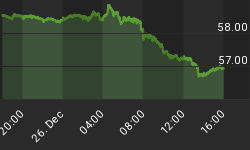This Friday on June 10th, the April trade balance will be released. Expectations are for US$58 billion, up from $55 billion in March. In March, the trade deficit had "unexpectedly" narrowed, mostly due to a slowdown of US economic activity.
As the currency markets anticipate Friday's report, let us keep a few things in mind. First, $58 billion is a very large number; annualized, the U.S. is anticipated to import $700 billion more worth of goods and services than it exports. For the U.S. dollar to remain stable, the trading partners will have to accumulate U.S. dollars at a rate of close to $2 billion a day. For the dollar to fall, foreign trading partners don't need to stop buying U.S. dollars, they merely need to buy less, for example by diversifying to other hard currencies.
When a slight narrowing of the trade deficit was released last month, the U.S. dollar received short-term relief (the turmoil with the European constitution also helped the dollar short-term). While many of us are fixated with a trade deficit that few economists believe is sustainable, a lower trade deficit is not automatically good news.
The balance of trade is affected by economic activity domestically and abroad. To correct the global imbalances, increased consumption outside of the U.S. or a higher savings rate inside the U.S. would be helpful. However, Europe remains stagnant, and Asia is expected to slow its rapid growth. Conversely, we do not expect U.S. real incomes to rise sharply, as the global imbalances make this exercise an uphill struggle. Global overproduction (through Asian currency subsidy and U.S. fiscal and monetary policies) leads to high raw material costs; a flood of cheap Asian goods combined with a highly indebted U.S. consumer provide for little pricing power. The result is accelerated outsourcing, not exactly the recipe for real income growth as the U.S. labor force is the one being outsourced.
This leaves an economic slowdown in the U.S. as a path to reduce the trade balance. While this "consumers voting with their feet" scenario may be unavoidable sooner or later, it is certainly not a scenario for anyone to look forward to. It would mean that the economy is slowing down, leaving consumers with a lot of debt, and the housing market in danger territory. Consumers may then opt to cash in any "liquid" assets, most notably their stock holdings to reduce their debt. Asian central banks would have less of a need to purchase U.S. dollars, making the dollar more vulnerable.
Asia is subsidizing their dollar exports to stimulate growth to provide jobs for their population as more and more rural workers migrate to cities. Despite wide anticipation that some day Asia will "give up on" the dollar, Asia won't leave this party without a fight. Asia's growth depends on a healthy U.S. economy. We would not be surprised to have some Asian countries revert to desperate policies, similar, yet more extreme to those of the Bank of Japan exhibited over the past years, to keep their currencies weak. And while Japan has not yet succeeded in wrecking its currency, if Japan and other Asian countries try hard enough, one day they might just succeed.
Unless the structural imbalances are addressed in a serious manner, with a policy shift that encourages savings, the pressure on the dollar is unlikely to disappear. In the current environment, policy makers choose between driving the imbalances to further extremes (the Organization for Economic Cooperation and Development, OECD, is warning of a $900 billion trade deficit next year), or a recession.
This Friday, I am invited again to appear on CNBC, ahead of the release of the trade balance (my appearance is scheduled for 5:20am ET) to comment on the currency markets. The analysis above may help you understand why we brought the Merk Hard Currency Fund to market. As the global imbalances may be unfolding, we provide the Fund as a tool to allow investors to diversify their portfolios. Stock & bond markets, the housing market and U.S dollar cash are all at increased risk. Our focus on "hard currencies" including gold, rather than some speculative Asian currencies aims at the investor seeking hard currency exposure without the speculative environment a turbulent Asia may provide. As Asia diversifies their currency holdings, hard currencies may benefit; at the same time, we seek to avoid the risk associated with Asian countries that have in the past shown that they do not yet have a culture that fosters long-term price stability.
















